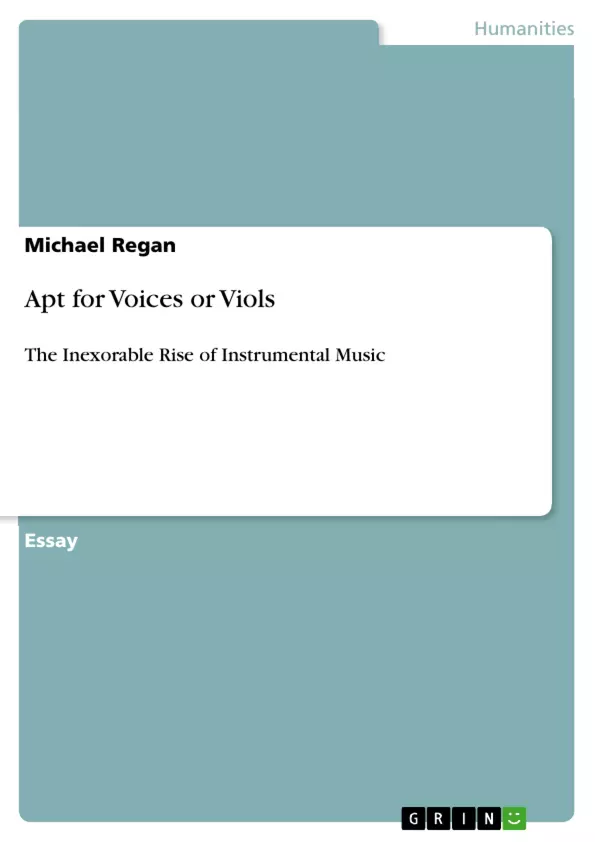“…music grew too proud to be the garment of words.” (W.B. Yeats) This, by a poet who was, allegedly, tone deaf, is nevertheless a concise but very astute summing up of what has happened to music since about the end of the 16th century. Yeats’ definition of music as “the garment” of words suggests admirably an earlier relationship of music to text- both adorning it and taking its form from it, as we can observe in the mass, motet, madrigal and other Medieval and Renaissance vocal forms in which the musical structures are largely determined by the words set. But after about 1600 music began to dissociate itself from words in earnest and go its own way, and the main cause of this was the rise in popularity of music purely for instruments. Of course there was instrumental music before 1600- lute and keyboard pieces for example, but it had been subsidiary and had never taken the chief place in the output of composers as it was increasingly to do in later times. Also it was very much bound up with the dances of the period- pavanes, galliards and so on- and therefore not so much music for listening to as for directing and co-ordinating bodily movements. What was new in the history of Western music after 1600 was the rapid rise of what another profound thinker about music, Ernst Krenek refers to as “autonomous music”- symphonies, concertos, string quartets, sonatas and fantasies etc., expressly written to be listened to and appreciated as things of beauty and value in their own right, and serving no extra- musical purpose.
Inhaltsverzeichnis (Table of Contents)
- The Inevitable Rise of Instrumental Music
- From Vocal to Instrumental Music
- Autonomous Instrumental Music
- The Rise of Instrumental Music
- The Continued Relevance of Vocal Music
- The Future of Music
Zielsetzung und Themenschwerpunkte (Objectives and Key Themes)
This text explores the historical development of instrumental music in Western music, focusing on its rise to prominence and the subsequent decline of unaccompanied vocal music. It examines the transition from music that was primarily vocal and text-driven to the development of autonomous instrumental forms. The text highlights the changing relationship between music and words, and the increasing reliance on instruments in musical genres like opera and oratorio.
- The historical development of instrumental music
- The influence of vocal music on early instrumental forms
- The emergence of autonomous instrumental music
- The relationship between music and words
- The impact of technology on the future of music
Zusammenfassung der Kapitel (Chapter Summaries)
This section explores the gradual shift from vocal music, where music was primarily a "garment" for words, to the rise of instrumental music. It highlights the early forms of instrumental music, like lute and keyboard pieces, and their association with dance. The text then introduces the concept of "autonomous music" and explores the reasons why it hasn't gained widespread acceptance among the general public.
The text discusses the evolution of instrumental style, starting from early ensemble music that imitated vocal forms to the development of unique instrumental forms like the sonata and concerto. The rise of the violin is identified as a key turning point in the separation of instrumental music from vocal music.
The text examines the ongoing connection between instrumental and vocal music, despite the development of autonomous instrumental forms. It explores the common occurrence of song-like themes in orchestral and chamber works, and how this continues to attract a wider audience. The text contrasts this with the challenges of appreciating "absolute" instrumental music, which seeks to convey meaning through pure sound patterns.
This section delves into the future of music, predicting a shift towards electronic music and synthetic sounds. The author anticipates the possible marginalization of traditional instrumental music in the future, as technology continues to evolve.
Schlüsselwörter (Keywords)
The central concepts explored in this text include instrumental music, vocal music, autonomous music, the relationship between music and words, the evolution of musical forms, and the influence of technology on musical development.
- Quote paper
- Michael Regan (Author), 2012, Apt for Voices or Viols, Munich, GRIN Verlag, https://www.grin.com/document/195405



